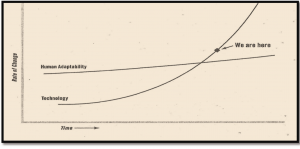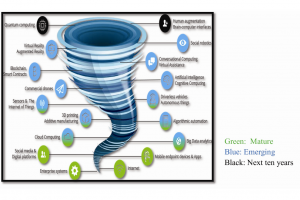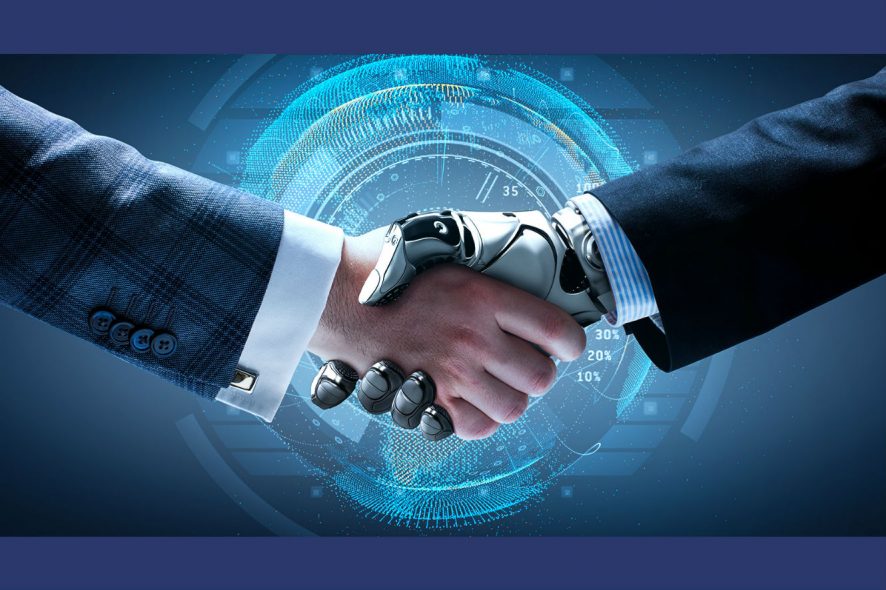“Digital technologies are doing for human brainpower what the steam engine and related technologies did for human muscle power during the Industrial Revolution. They are allowing us to overcome many limitations rapidly and to open up new frontiers with unprecedented speed. It is a very big deal. But how exactly it will play out is uncertain.”
— Andrew McAfee
What are the Major Trends in Digital Technology (DT)
Due to the ripening of digital technologies, the society en bloc is undergoing a fast and radical transformation. To add to the increased demand from customers, companies are facing ever tougher competition due to globalisation and putting pressure to go digital before others do, seeking to survive and attain competitive advantages.
Hence, in recent years “born digital” pioneers (e.g., Amazon, Facebook and Google) have grown into powerful behemoths, while companies that long dominated their industries found their traditional value proposition under threat.[1]
Further to be added that every computing device [which has five basic components: (a) integrated circuits; (b) memory; (c) network systems; (d) software applications; and (e) sensors] is undergoing changes which humans cannot absorb. The biggest concern is what happens next? How could we legislate technology, we neither understand nor can predict its legal application/misapplication?

What will the Digital Technology Innovation Ecosystem Look Like in the Next Ten Years
In the impending ten years, the computer will eventually disappear, and will be everywhere but invisible (IOT). Music was the first industry to be digitised. Now it is media. Tomorrow, it is education, banking, medicine and transportation, etc. The table below explains the scenario is as follows:
| Mature | Emerging | Futuristic |
|
(i) Enterprise systems (ii) Internet (iii) Social Media and digital platforms (iv) Mobile endpoint devices and Apps
|
(i) Cloud computing
(ii) Big data analytics (iii) 3D printing/additive manufacturing (iv) Algorithmic automation (v) Sensors and the internet of things (vi) Driverless vehicles and autonomous things
|
(i) Commercial drones (ii) Artificial intelligence and cognitive computing (iii) Blockchain, smart contracts (iv) Conversational computing (v) Virtual assistance (vi) Virtual reality and augmented reality (vii) Social robotics (viii) Quantum computing (ix) Human augmentation/brain-computer interfaces |

Big Data: The New Gold Mine
Big data relates to large data. Big data challenges include capturing data, data storage, data analysis, search, sharing, transfer, visualisation, querying, updating, privacy and data source. Currently, the term “big data” tends to refer to the use of predictive analytics, user behaviour analytics, or certain other advanced data analytics methods that extract value from data.
Analysis of data sets can find new correlations to spot business trends, prevent diseases, combat crime and so on. Researchers, scientists, business executives, practitioners of medicine, and governments alike regularly need to mine and understand large data sets in areas including urban informatics and business informatics.
Challenges to Intellectual Property (IP) Law in “DT” Innovation
3D printing—3D printing could be a problem for patent-holders as its enforcement will be hard due to dispersed infringers. Only by simply removing the mark the 3D printing could overcome trade mark or trade dress. The jurisprudence is not conventional as case laws and legislation needs to be developed to manage 3D products/services. Moreover, the copyright system itself is not ready to respond to the challenges posed by DT acceleration. Also, patent law doctrines will be disrupted and may need to undergo certain legislative changes.
Artificial Intelligence (AI)
Businesses are increasingly interested in protecting their investments in the development of AI. Due to low cost, high-capacity storage and computing power, and the ubiquity of sensors that capture data of all types, companies are adding AI features to existing products and creating entirely new product offerings based on AI.
The world of “big data” has created both the availability of robust training sets used to develop AI technology and a need for technology that can process and filter large volumes of data for business applications. Recognising the need to protect the value of their investment in AI, companies are increasingly securing IP protection. The Patent and Trade Mark Office (PTO), for example, has seen a 500 per cent increase in the past five years in the number of patents issuing to Class 706, a classification exclusively designated for AI data processing systems.
Currently, inventors are individuals. But what if an AI-enabled machine invents something? What if an AI algorithm — without any human intervention — develops a new drug, a method of recognising diseases in medical images, or a new blade shape for a turbine? Section 100(f) of the Patent Act, 35 USCA Section 100(f) defines “inventor.” The legislative history of that section indicates that Congress intended statutory subject matter to “include anything under the sun that is made by man”, according to the US Supreme Court.[2] Accordingly, perhaps Congress, and not the courts, may have to make changes to existing patent law to address potentially patentable subject-matter developed autonomously by AI.
Underlying the patent laws is a contractual consideration. In exchange for a limited monopoly via a grant to exclude others from practising the claimed invention, an inventor must disclose to the public enough information about the invention to enable one of ordinary skills in the art to practice what is claimed.
Given the nature of some AI inventions, meeting this requirement can be challenging. For example, when seeking protection for rule-based AI systems, a research team may have developed rule sets that are effective for a specific application. Patent claims directed to a broader scope of application may not be enabled by the rules developed. Disclosing only those specific rules may not satisfy the disclosure obligations of Section 112 of the Patent Act, 35 USCA Section 112.
Similarly, the performance of AI embodied in artificial neural networks can depend on network topology, which can include the number and types of layers, the number of neurons per layer, neuron properties, training algorithms and training data sets. The scope of the claims will depend on what the limited set of topologies disclosed in the patent teaches one skilled in the art to practice.
In both the rule-based and network-based systems described above, where the systems have been developed heuristically, there may be questions regarding whether the patent discloses generalisations necessary to support the desired claim scope. There could be millions of permutations of the network architecture or rules adaptable for various applications.
Disclosing only a few and trying to define a broad claim scope may introduce risks. Providing a comprehensive disclosure laying out many embodiments may reduce some risk. But practically, how many can and should be disclosed? This is an area where guidance may come from the pharmaceutical arts, which may aid in an understanding of the bounds of patent disclosure and written description requirements.
Under Section 101 of the Patent Act, 35 US CA Section 101, the subject-matter of a patent claim must be directed to a “process, machine, manufacture or composition of matter”. However, the US Supreme Court held[3], that claims directed to nothing more than an abstract idea, such as a mathematical algorithm, or to natural phenomena or a law of nature are not eligible for patent protection. The technology underlying AI is generally based on computer programming or hardware implementing mathematical models, deep learning algorithms or a neural network. An improperly drafted patent application directed to AI may fall within this judicially recognised exception to patent-eligible subject-matter.
In Alice Corpn. Pty. Ltd. v. CLS Bank International[4], the Supreme Court provided the framework for determining “whether the claims at issue are directed to a patent-ineligible concept”. If the claims are, then the elements of all claims must be examined “to determine whether (they contain) an ‘inventive concept’ sufficient to ‘transform’ the claimed abstract idea into a patent-eligible application.”[5]
The US PTO expressly recognises that AI can be patentable through the express designation of Class 706, a section of the agency’s patent application classification system. In addition, two PTO “examining art units” for reviewing prior art are specifically devoted to reviewing applications directed toward AI algorithms.
Copyrights can be used as another form of protecting AI, because AI software can be copyrightable. In Synopsys Inc. v. ATopTech Inc.[6] Synopsys had patents directed to static timing analysis but instead relied exclusively on its copyrights of the software to secure a jury award of over $30 million based on ATopTech’s alleged infringement of Synopsys’ copyright.
Whether AI that is capable of generating copyrightable material can obtain a copyright is a different matter. A District Court recently found that a monkey had no rights to his selfie because the current copyright statute as interpreted affords rights to humans, not animals. This case demonstrates that future legislation would likely be required to allow animals, or AI for that matter, to obtain copyright protection.
AI and the IP issues it presents are continuing to evolve, creating a new frontier for businesses, governments, academicians and legislators. We need to consider changes in the law to employ the appropriate legal strategies to guide them as they deploy and protect AI-based innovations.
What can India do to Compete in the DT Space? Problems and Solutions
World Bank data estimates 69% of today’s jobs in India are threatened by AI-driven automation. China’s figure is 77%. Still, robots replacing jobs en masse is unrealistic in the medium term in India (or anywhere else) but the effects are already being felt. Last September, Indian textiles giant Raymond said it would replace 10,000 jobs with robots over three years. India lags well behind the developed world on labour productivity, which acts as a major drag on growth. We have to automate to be globally competent. Infrastructure supports productivity enabling to compete globally. The jobs of the future will focus on skills like critical thinking, collaboration and creativity. In this India’s education system also has a major role to be played, therefore it must prepare young people to participate and lead in the global DT industry.
Although the scenario has changed and India has realised that the Date is GOLD! India looks to “level playing field” with US tech giants. Indian lawmakers are looking for ways to curb the power of US tech giants with draft rules calling for companies to store local user data in India with the information accessible to the Government. The Wall Street Journal viewed a draft of a new e-commerce policy calling for a “level playing field” with rules for “encouraging domestic innovation and boosting the domestic digital economy to find its rightful place with dominant and potentially non-competitive global players”.[7]
Indian policymakers are looking for ways to tamp down American tech behemoths, a shift that could crimp growth potential in one of the biggest remaining open markets for their expansion. India wants to slap new rules on Amazon.com Inc., Apple Inc., Alphabet Inc.’s Google, Facebook Inc. and other firms, using a page from China’s playbook to take control of its citizens’ data and shelter homegrown startups. Lastly, in today’s DT space, India must develop indigenous capabilities in DT research involving all fields and build human capabilities in AI.
*Vaishali Singh is Research Associate, GNLU-Microsoft IPR Chair, Gujarat National Law University.
[1] See,?<https://www.researchgate.net/publication/310790993_Synergy_for_Digital_Transformation_Person’s_Multiple_Roles_and_Subject_Domains_Integration>.
[2] Diamond v. M. Chakrabarty, 1980 SCC OnLine US SC 128 : 65 L Ed 2d 144 : 447 US 303 (1980).
[3] Diamond v. R. Diehr, 1981 SCC OnLine US SC 41: 67 L Ed 2d 155: 450 US 175 (1981).
[4] 134 S. Ct. 2347.
[5] Ibid.
[6] 13–cv–02965–MMC(DMR).
[7] See, <https://seekingalpha.com/news/3382109-wsj-india-looks-level-playing-field-u-s-tech-giants>






